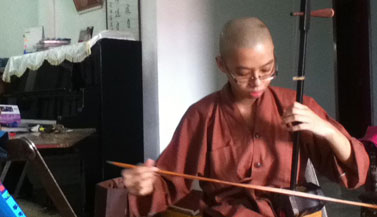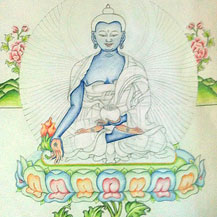Home > Artist > Travel & Photography > Thailand
Buddhist Kingdoms, Elephants & fine Arts in Thailand



Siam
Thailand is formerly known as the Kingdom of Siam.
The primary religion is Theravada Buddhism, which is practised by around 95% of the population and an integral part of Thai identity and culture.
The beautiful gold-on-red deity on the left is painted in the typical Thai Lanna art style. The creature on the right -a blue lion?- looks very fierce and helps to keep the negative spirits out of the temple.



Sukhothai
The 12th-13th century Buddhist Kindom of Sukhothai, a large area with lots of temples is a Unesco Heritage site and a true gem that’s definitely worth visiting. Sukhothai offers 193 ruins on 70 square kilometers of land.
The picture on the left shows a close up of a big buddha statues where devotees offered gold leaf on the nails of the Buddha. The center shows one of the many beautiful temple complexes in the area.
On the right a big banyan tree where buddha statues are placed in between his roots.



The Art of Chiang Mai
Here a few pictures of Chiang Mai, the largest and most culturally significant city in northern Thailand.
Chiangmai is known for its many old Buddhist temples and monasteries. It’s a joy to wander from temple to temple and feel the atmosphere, smell the incense and watch the monks and the devotion of the people.
Most temples are full of wonderful ornaments, such as these gold on red decorations on the pillars in the temple that’s completely made out of wood.
On the right an ‘advertisement’ in front of one of the temples that talks about the very basics of Buddhism: ‘Do Good, Avoid Bad and Purify
one’s own Mind’. This could be the practice for the rest of your life.



Detailed murals
Most temples are full of wonderful mural paintings. Often the life of the Buddha is depicted (center), as well as scenes from the previous lives of the Buddha (the ‘Jatakas’, mainly the last ten incarnations).
Just as Tibetan paintings, Thai mural temple paintings are highly stylistic and a lot of symbols are used in them. The left and right picture show beautiful miniature scenes of daily live in the villages.
Unfortunately, often mural paintings in Thailand are not well preserved. It seems to be common practice at temple compounds to abandon old buildings including its contents, and to build new buildings in place. As a result, many old buildings are neglected. Nowadays however, at certain sites some efforts are being made to restore and preserve these paintings.



Elephants and flying gods
The wall paintings inside the temples that can be modern or centuries old, can be looked at for hours. There’s so much to see and the style, colors and detail of the paintings are truly wonderful.
The painting on the left shows the Lanna art style. The modern painting of the flying god in the center wears Siamese royal clothes and is beautiful in color. The elephant on the right looks very vivid and in motion



The White Temple
This is the amazing White Temple, close to Chiang Rai in the north of Thailand.
It’s both a Buddhist temple & art project by one of Thailand’s best contemporary artists: Chalermchai Kositpipat.
You enter the temple through the hell realm (shown for example by the the grabbing hands from hell that you have to walk past) and then then you take the bridge (see centre picture) towards the realms of heaven, with its incredible artwork inside. On your way over the bridge towards the holiest part of the temple you’re not allowed to return, if you attempt to do so a person working there will let you know by megaphone!



Miniature scenes
The picture on the left shows another beautiful miniature painting scene.
The cat in the center pic sits at the entrance of a big temple compound and has the job of the temple protector.
On the right a super detailed sketch made by a modern young artist who was selling his artwork in front of a monastery in Chaing Mai. This is a typical thai design of a naga snake or dragon creature. I bought some of his work to support this artist.



Broken tiles
Intriguing about many temples in Bangkok is that they are adorned with Chinese ceramic and (broken) tiles.
The origin of this particular style of decoration stems from long ago, from the time when the trading boats were coming from China, filled with ceramics. The tiles and ceramics that hadn’t survived the trip and arrived broken were left behind in Bangkok, in order not to carry the
ballast on the rest of the journey. The inventive Thai people didn’t throw it away but used these broken ceramics to create lovely and cheap temple decorations.



Medical studies
One of the large temple compounds in Bangkok hosts a school for medical studies.
On the inside and outside walls of the building one can find many paintings of medical paintings, for example showing the many different energy points in the body (see left and right pic).
In the evenings you can watch the beautiful sunset at the Bangkok river (the Chao Phraya River) where lots of Buddhist temples are located alongside of it.


Taking care of an Elephant
I lived some days in a working elephant village with about 90 elephants right around me. Click here to read more about that adventure.


Buddhist Pilgrim Sites
In another trip to Thailand I visited more Buddhist pilgrim sites and old kingdoms, such as Ayutthaya.
I also made a special trip to visit the lesser known pilgrim sites and old buddhist kingdoms Phimai, Phanom Rung and Muang Tam, in the eastern part of Thailand (Isan region). They are part of a very ancient Pilgim Route from Angkor Wat in Cambodia to the Phimai temple in Thailand, called the Dharmasala Route. As Angkor, the other temples are also built in the typican Khmer style.
Click here to read more about Thai Pilrim sites & Buddhist Kingdoms
> India > Nepal > Tibet > Myanmar/Burma > Bali > Malaysia > Indonesia > Singapore
 A gorgeous statue
A gorgeous statue Buddhism traveled to China
Buddhism traveled to China How to draw and paint Guan Yin
How to draw and paint Guan Yin Do you want to learn how to draw and paint this amazing female Buddha of Compassion?
Do you want to learn how to draw and paint this amazing female Buddha of Compassion?






 I’m very happy to announce that Happinez Magazine* will bring out an article about me and my work that will be published in their next issue (that will come out on June 1st). The interview (by Marja den Boer) and photo shoot (by Harold Pereira) were scheduled for for this month, as well as a video shoot that will be published on their website.
I’m very happy to announce that Happinez Magazine* will bring out an article about me and my work that will be published in their next issue (that will come out on June 1st). The interview (by Marja den Boer) and photo shoot (by Harold Pereira) were scheduled for for this month, as well as a video shoot that will be published on their website.







 Before you enter the temple you are welcomed by ponds full of water lilies.
Before you enter the temple you are welcomed by ponds full of water lilies. It’s a temple full of details, and dedicated to Nataraja, the Dancing Shiva.
It’s a temple full of details, and dedicated to Nataraja, the Dancing Shiva.










 Villages around the Borobudur
Villages around the Borobudur




 Death procession and cremation ceremony
Death procession and cremation ceremony






































































































 Some pictures of Bodhgaya, the holy place where
Some pictures of Bodhgaya, the holy place where 


 The ceremony lasted for several days and the picture in the center shows part of the ceremony where the debate on Buddhist philosophy is taking place.
The ceremony lasted for several days and the picture in the center shows part of the ceremony where the debate on Buddhist philosophy is taking place.







 [/su_content_slide]
[su_content_slide]
[/su_content_slide]
[su_content_slide] [/su_content_slide]
[su_content_slide]
[/su_content_slide]
[su_content_slide] [/su_content_slide]
[su_content_slide]
[/su_content_slide]
[su_content_slide] [/su_content_slide]
[/su_content_slider]
[/su_content_slide]
[/su_content_slider]




 Carmen offers courses for youth and school groups, in high schools and museums.
Carmen offers courses for youth and school groups, in high schools and museums.